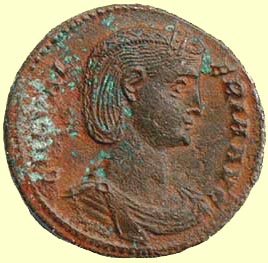 Contents -
Previous Article -
Next Article
Contents -
Previous Article -
Next Article
The story of Galeria Valeria is a tragic and poignant one of an empress whose life and death were totally dictated by the politics of the period. There seems to be little she could have done to influence the events that controlled her life and in the end brought about her untimely death.
The lives of women of the imperial family during the later Roman Empire are very well documented, thanks to the emergence of several sources during this period of renewed prosperity and vigor for the empire. During the late Third and early Fourth Centuries, the political moves of Diocletian and the Tetrarchy determined who the emperors would marry and politics took total control of the lives and futures of the women to whom they were married. In A. D. 293 Diocletian chose Galerius, another Illyrian general to help him rule the huge Roman empire, for he realized that it had become too large for one man to rule successfully. Diocletian ruled in the West and Galerius became his co-emperor in the East. Galeria Valeria was Diocletian's daughter and, to cement the alliance between Diocletian and Galerius, Valeria was married to Galerius. It appears that this was not a very happy marriage. Galeria Valeria was sympathetic towards Christians during this time of severe persecution and it is possible that she was actually a Christian herself. The imperial couple were not blessed with any children during their eighteen year marriage. After Galerius died in A. D. 311, Galeria Valeria and her mother went to live at the court of Maximinus Daia, the caesar who became emperor of the East upon the death of Galerius.
Maximinus proposed marriage to Valeria soon afterward. He was probably more interested in her wealth and the prestige he would gain by marrying the widow of one emperor and the daughter of another than he was in Valeria as a person. She refused his hand, and immediately Maximinus reacted with hatred and fury. Diocletian, by now an old man living in a seaside villa on the Dalmatian coast, begged Maximinus to allow the two women to come home to him. Maximinus refused and had Valeria and her mother banished to live in a village in Syria.
During the civil war that erupted between Maximinus and Licinius, Valeria and Prisca disguised themselves and escaped, trying to reach the safety of Diocletian's villa. In the meantime, Diocletian had died, leaving the women without a haven of safety to which to run. For fifteen months the two royal fugitives traveled from one city to another, always living in fear of being discovered and in search of a little peace.
Finally, they were recognized by someone in the Greek city of Salonika. They were hastily taken to a square in the city and beheaded before a crowd of citizens who had once revered them as empresses. The bodies of Valeria and her mother were afterwards thrown into the sea.
Coin portraits of Galeria Valeria depict a strong, almost masculine face with a large jaw and prominent chin. She probably did not look much like her portraits, though. The style used for imperial coin portraits showed all four Tetrarchs and their later caesars and co-emperors with thick necks, large jaws, prominent brows, and an overall :tough guy" appearance. In fact, all the portraits of these men look very much alike except the portraits on special issues or medallions which were occasionally struck as gifts to royalty or as rewards for military achievement. Many scholars believe that this style of portraiture was intended to convey the image of a tough, united, no-nonsense group of men who ruled as imperial brothers who could not be divided and turned against each other. When it came time to strike coins in Valeria's name, it almost seems that they took the standard imperial portrait and did only what little they absolutely had to in order to make it look like a woman's face!
Go to next article: on Theodora, First Wife of Constantius I
Go back to previous article: on Zenobia